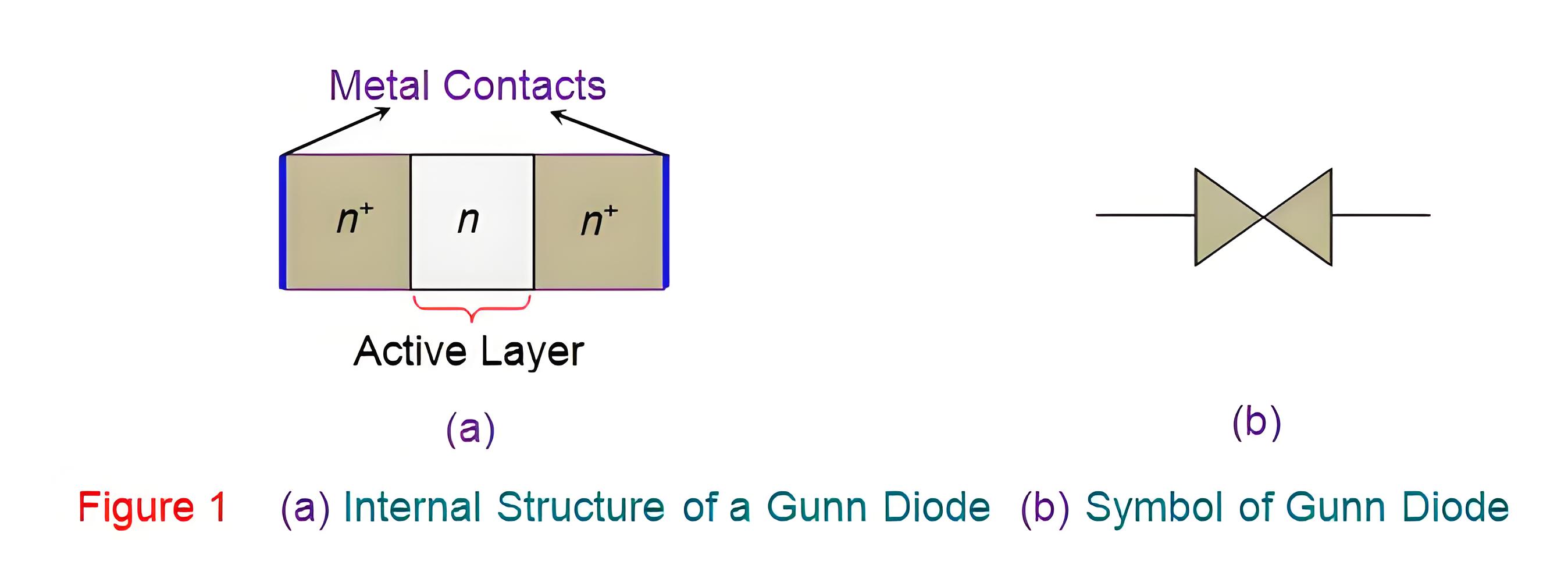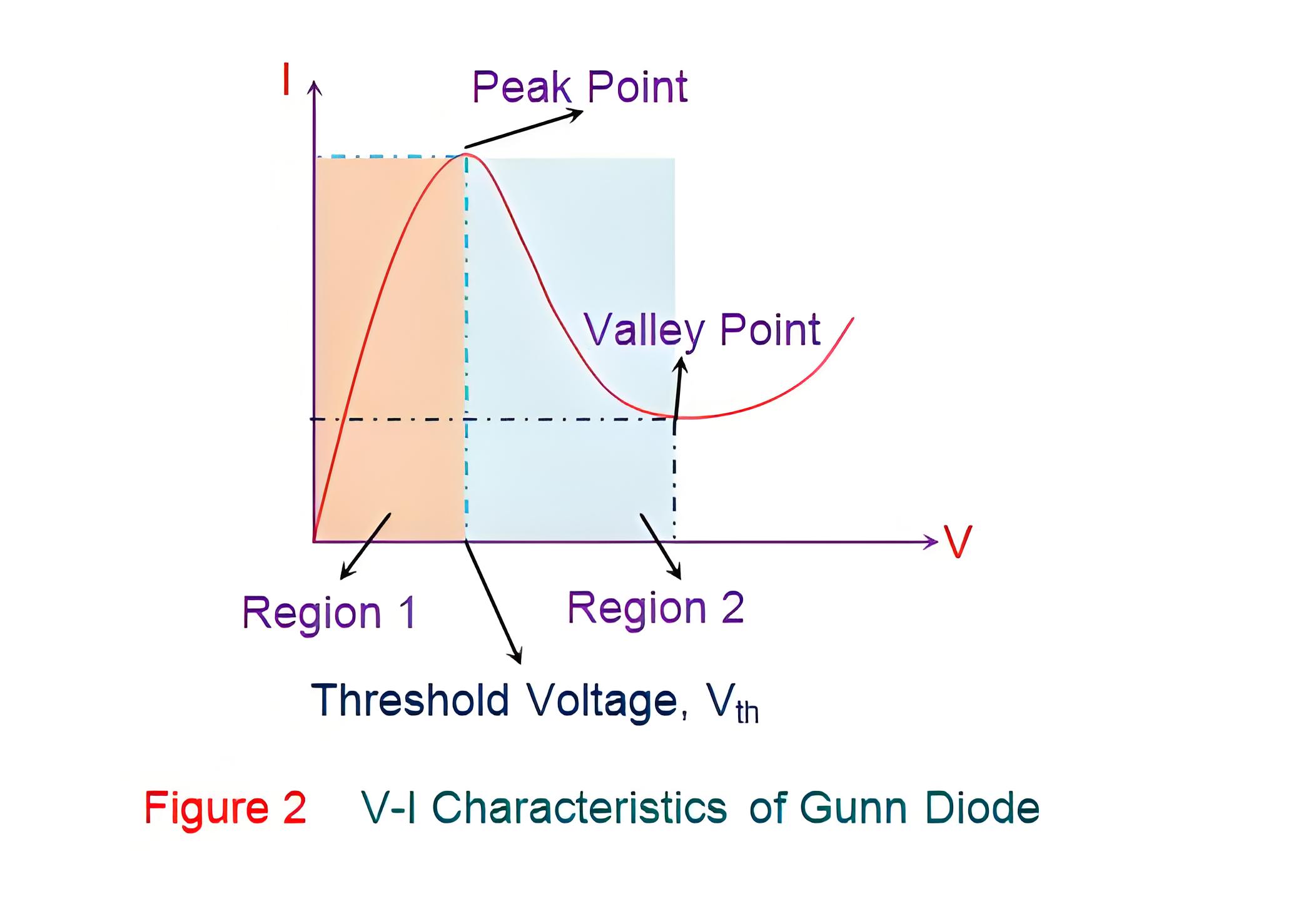What is a Gunn Diode?
What is a Gunn Diode?
Gunn Diode Definition
A Gunn diode is a passive semiconductor device with two terminals, which composes of only an n-doped semiconductor material, unlike other diodes which consist of a p-n junction. Gunn diodes can be made from the materials which consist of multiple, initially-empty, closely-spaced energy valleys in their conduction band like Gallium Arsenide (GaAs), Indium Phosphide (InP), Gallium Nitride (GaN), Cadmium Telluride (CdTe), Cadmium Sulfide (CdS), Indium Arsenide (InAs), Indium Antimonide (InSb) and Zinc Selenide (ZnSe).
General manufacturing procedure involves growing an epitaxial layer on a degenerate n+ substrate to form three n-type semiconductor layers (Figure 1a), where-in the extreme layers are heavily doped when compared to the middle, active layer.
Further the metal contacts are provided at either ends of the Gunn diode to facilitate biasing. The circuit symbol for Gunn diode is as shown by Figure 1b and differs from that normal diode so as to indicate the absence of p-n junction.

When a DC voltage is applied to a Gunn diode, an electric field develops across its layers, especially in the central active region. Initially, conduction increases as electrons move from the valence band to the lower valley of the conduction band.
The associated V-I plot is shown by the curve in the Region 1 (colored in pink) of Figure 2. However, after reaching a certain threshold value (Vth), the conduction current through the Gunn diode decreases as shown by the curve in the Region 2 (colored in blue) of the figure.
This is because, at higher voltages the electrons in the lower valley of the conduction band move into its higher valley where their mobility decreases due to an increase in their effective mass. The reduction in mobility decreases the conductivity which leads to a decrease in the current flowing through the diode.
As a result, the diode exhibits a negative resistance region in the V-I characteristic curve, spanning from the Peak point to the Valley Point. This effect is known as the transferred electron effect, and Gunn diodes are also called Transferred Electron Devices.

Further it is to be noted that the transferred electron effect is also called Gunn effect and is named after John Battiscombe Gunn (J. B. Gunn) after his discovery in 1963 which showed that one could generate microwaves by applying a steady voltage across a chip of n-type GaAs semiconductor. However it is important to note that the material used to manufacture Gunn diodes should necessarily be of n-type as the transferred electron effect holds good only for electrons and not for holes.
Since GaAs is a poor conductor, Gunn diodes generate excessive heat and need a heat sink. At microwave frequencies, a current pulse travels across the active region, initiated at a specific voltage. This pulse movement reduces the potential gradient, preventing further pulse formation.
A new current pulse can only be generated when the previous pulse reaches the far end of the active region, increasing the potential gradient again. The time it takes for the current pulse to travel across the active region determines the pulse generation rate and the operational frequency of the Gunn diode. To vary the oscillation frequency, the thickness of the central active region must be adjusted.
Further it is to be noted that the nature of negative resistance exhibited by the Gunn diode enables it to work as both an amplifier and an oscillator, the latter of which is known as a Gunn diode oscillator or Gunn oscaillator.
Gunn Diode Advantages
Lies in the fact that they are the cheapest source of microwaves (compared to other options such as klystron tubes)
They are compact in size
They operate over a large bandwidth and possess high frequency stability.
Gunn Diode Disadvantages
They have a high turn-on voltage
They are less efficient below 10 GHz
They exhibit poor temperature stability.
Applications
In electronic oscillators to generate microwave frequencies.
In parametric amplifiers as pump sources.
In police radars.
As sensors in door opening systems, trespass detecting systems, pedestrian safety systems, etc.
As a source for microwave frequencies in automatic door openers, traffic signal controllers, etc.
In microwave receiver circuits.
The Electricity Encyclopedia is dedicated to accelerating the dissemination and application of electricity knowledge and adding impetus to the development and innovation of the electricity industry.













